Media | Articles
8 fiberglass cars that made plastic fantastic
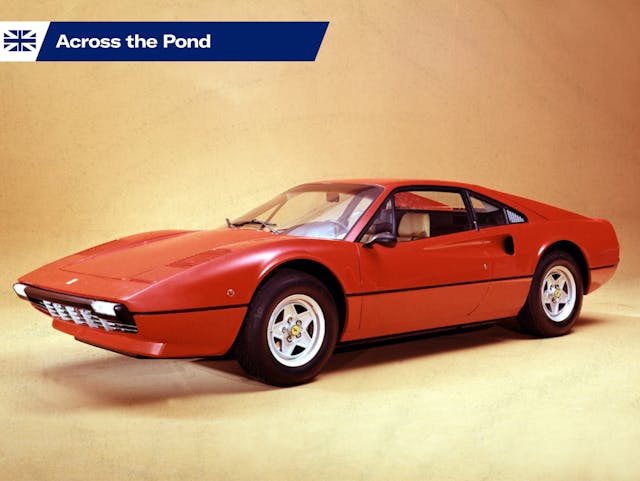
The Corvette may be the most popular fiberglass-bodied car by volume, but it wasn’t the first—and it certainly isn’t the most exotic. Have a read of this list, compiled by our U.K. colleagues, and reinforce your belief in the fantastic possibilities of plastic. —Ed.
Though the British motor industry has been doing fantastic things with plastic for around seven decades, the history of fiberglass body construction goes back even further. In his excellent book Excess All Areas: British Kit Cars of the 1970s, Richard Heseltine charts the use of fiberglass in the United States, kickstarted in 1936 by the Owens-Illinois glass company and its pioneering use of continuous fibers of glass, using the trade name Fiberglas.

Five years later, Henry Ford unveiled the Soybean Car (above), which utilized 14 plastic panels attached to a steel tubular frame. According to The Henry Ford Museum of American Innovation, the body’s ingredients included soybeans, wheat, hemp, flax and ramie.
Today, the use of fiberglass is synonymous with the British specialist and sports car industries, but it’s a truly global affair.
1953 Chevrolet Corvette

The American Bill Tritt had been building fiberglass boats for two years when he was approached by friend Major Ken Brooks. Tritt was tasked with creating a European-style roadster based on the chassis of an old Willys Jeep, in which Brooks’ wife refused to travel. The result was the Brooks Boxer, which became the Glasspar G2, a car credited as being the world’s first fiberglass sports car.
Marketplace
Buy and sell classics with confidence
Tritt went on to design and build fiberglass cars for a range of companies, but his role in the creation of the Chevrolet Corvette is often overlooked. The G2 was presented to Harley Earl, General Motors’ vice-president in charge of styling. For Earl, it was a source of inspiration; the use of Glass-Fiber-Reinforced Plastic (GRP) would save money on tooling while underlining the Corvette’s position as the American sports car of the future.
GM’s promotional material extolled the virtues of the Corvette’s “two-passenger, open-cockpit body of glass-fiber reinforced plastic; light, strong, durable, rustproof, quiet and easy to repair.” For New Yorkers at the 1953 Motorama, plastic truly looked fantastic. And so began seventy years of series production.
1958 Jensen 541
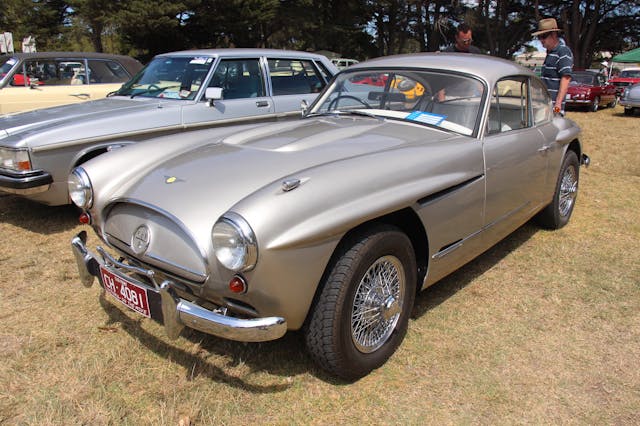
On the other side of the Atlantic, Jensen was readying the world’s first four-seater car—and Europe’s first series production performance car—with a fiberglass body. The combination of a 4.0-liter straight-six engine and lightweight, aerodynamic body made it one of Britain’s fastest cars of the 1950s.
Jensen remained faithful to fiberglass construction with the 541R (pictured), 541S, and C-V8, before the arrival of the Interceptor in 1966 saw a return to a steel body shell.
1961 Lotus Elite
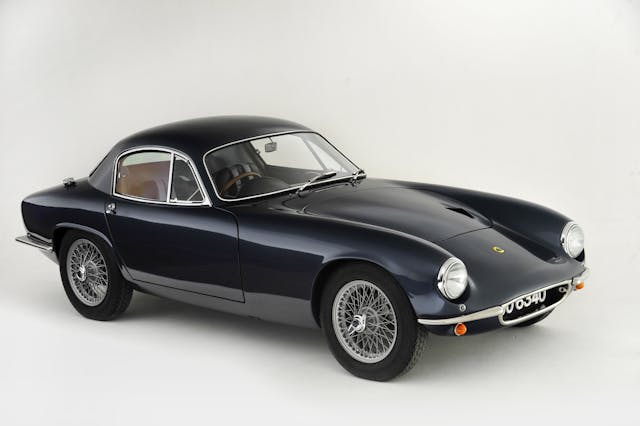
The Lotus Elite was one of the most revolutionary and significant cars of the 1950s. Unlike the Corvette, whose fiberglass panels were mounted on a separate chassis, the Elite featured a monocoque built entirely of fiberglass. This was the first time fiberglass had been used for the whole load-bearing structure of the car. The result was a car that weighed about the same as a bag of sugar, with a drag coefficient of just 0.29—in 1957!
The first 250 bodies were built by Maximar Mouldings of West Sussex, before quality issues saw the work being handed to the Bristol Aeroplane Plastics Limited. In an advertisement, Bristol called it “the most advanced car body ever built.” The copywriter probably had a point.
1958 TVR Grantura

A list of fiberglass cars wouldn’t be complete without a TVR, so it makes sense to feature the marque’s first production vehicle. The Grantura of 1958 featured a fiberglass body molded to TVR’s own tubular steel chassis, with the trailing arms and torsion bars from a Volkswagen Beetle.
Other components shipped in included the windscreen from a Ford Consul and the drum brakes from an Austin-Healey 100, along with a choice of engines sourced from Coventry Climax, Ford, and BMC.
1959 Daimler SP250
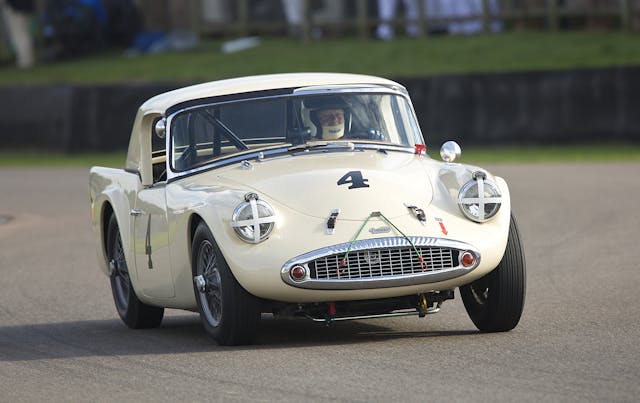
In some ways, the Daimler SP250 was the British Corvette. Launched as the Dart at the 1959 New York motor show, Daimler was forced to change the name to SP250 following a trademark complaint from Dodge.
Slow sales meant that the V-8-engined SP250 was the last hurrah for Daimler; the company was bought by Jaguar in 1960, before the axe fell on the sports car in 1964.
1970 Bond Bug
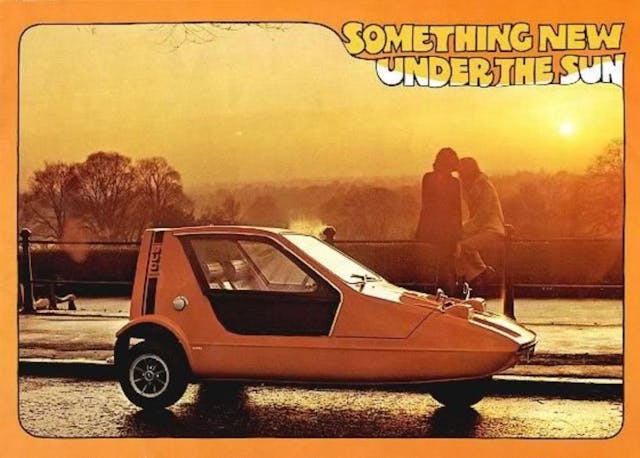
In an interview published in Classic.Retro.Modern. magazine, design genius Tom Karen named the Bond Bug and Marble Run as the two products of which he is most proud. With its orange paintwork, wedge shape, and black decals, the Bug is one of the most 1970s cars of the 1970s. In other news: It’s too long since we played Marble Run.
The brochure delivered a gloriously informal assessment of the benefits of a fiberglass body: “Rap the side of the Bug with your knuckle. There is no hollow, tinny sound; it gives a deep, solid thunk-thunk-thunk. The body of the Bug is made not of metal but of tough, reinforced glass fibre. There is a big advantage to you; because glass fibre cannot rust.”
Makes you thunk, doesn’t it?
1975 Ferrari 308 GTB
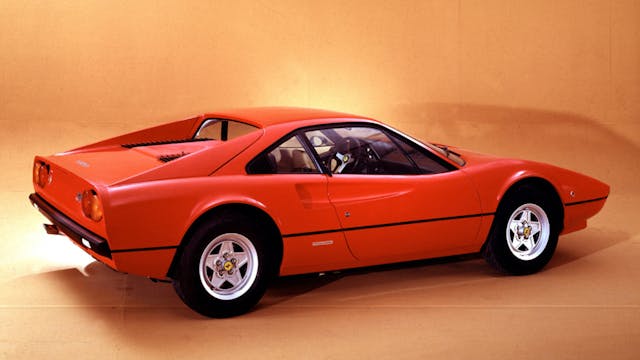
Many car names sound better in Italian: Quattroporte (four doors), Topolino (little mouse), Scuderia (stable), and Testarossa (redhead). So, it’s no surprise that the Ferrari 308 GTB “Vetroresina” sounds more exotic than the 308 GTB “Fiberglass.”
This was the first production Ferrari to feature a fiberglass body, but why did Maranello shift from steel? Probably because Ferrari needed to fast-track the development of a new car in response to the slow-selling 308 GT4. The subject of weight also played a part, while some historians speculate that Ferrari used fiberglass in case the car didn’t sell.
By late 1976, just a year after the 308 GTB made its debut at the Paris motor show, cars were arriving in the U.S. wearing steel bodies, although fiberglass cars remained on sale in Europe until the middle of 1977. Various reasons have been tabled for the switch from plastic to steel, including difficulty in finding specialists to repair accident damage, construction that was more labor-intensive than envisioned, and even the fact that fiberglass was never anything other than a temporary measure.
1977 Matra Rancho
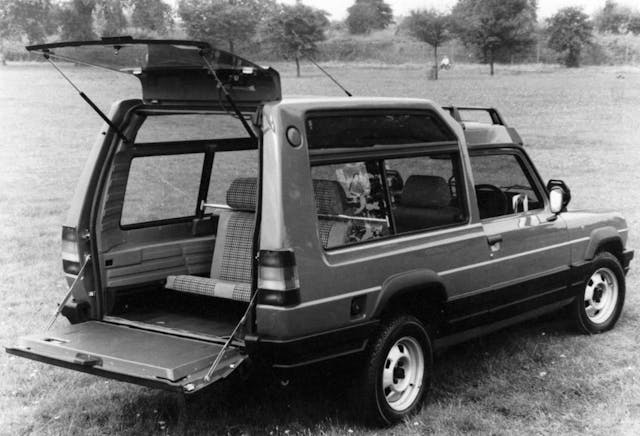
Forget all the nonsense about the Nissan Qashqai being the first crossover. Plenty of other manufacturers had previously attempted to blaze the trail, most notably the Matra Rancho of 1977.
Built to satisfy the needs of would-be Range Rover owners who wanted to talk the talk, but didn’t necessarily need to walk the walk, it pioneered the concept of a rough and ready SUV without the ability to venture further off-road than a dropped curb on the Kings Road.
The fiberglass rear section was mounted on a steel frame, the rusting of which doomed too many examples of the radical oddball. Matra stayed true to fiberglass construction with the development of the Renault Espace.
The others

There are countless other fiberglass cars we could have included. The Lancia Stratos, Citroën Bijou, Gilbern Invader, AC 3000ME, Clan Crusader, Vauxhall VX220, and Reliant Scimitar, to name just a few.
A separate list could feature more plastic creations from TVR and Lotus, not to mention the myriad kit cars produced during the boom in self-build vehicles. But before we further extol the virtues of the body material, read how difficult it can be to properly restore a fiberglass body.
Check out the Hagerty Media homepage so you don’t miss a single story, or better yet, bookmark it.







Jeez, didn’t the M-B people file suit against Jensen for ripping off the 300 SL (sans gull wings) design?
Not likely, as the Jensen came first!
So what are the facts? The lines of the 541 were first revealed to the public in October 1953 at Earls Court.
The prototype 300SL was shown at the International Motor Sports Show in New York City in February 1954.
Mercedes security was such that the design details came as a surprise to everyone, and it would not have been possible for Jensen to know of their design four months in advance, let alone back in the Summer of 1953 when the first 541 was styled.
Am I wrong but wasn’t the Avanti fiberglass. Also it was thicker than the Corvette.
You’re correct. The original Studebaker Avantis (1963-64), Avanti IIs (’70’s) and subsequent versions were all fiberglass bodies, including my 1972 Avanti II.
And my 1987 Avanti
And my 64
Yes, the article fell short not to include Raymond Lowe’s Studebaker Avanti design.
I have a 67 Avanti and yes it is fiberglass
Absolutely correct
More likely the reason Ferrari switched to metal was because they started selling in the Middle East. There are lots of stories there of camels eating fiberglass cars.
The 1954 Kaiser-Darrin deserves a mention, too. Designed by Howard “Dutch” Darrin, it has probably the coolest doors of any car, domestic or foreign.
Certainly right up there with the BMW Z1. I wonder if there were any other “pocket door” cars.
Thought for sure it would be on this list.
That’s what I was going to say. Uncle “Al” Lewis local Cincinnati TV personality had one.
Great Comment
Fiero was as plastic as it gets. It may yet today be the highest volume composite body car per sold by a year basis.
Bricklin?
Trabant.
Hey hyperv6, how about gracing us with your knowledge of the MERA? I barely remember some media stuff about them at the time, but have never seen much more about them, let alone one in the (plastic) flesh.
The Mera was basically the Fiero chassis with a scales 308 Ferrari styled body.
They were sold and warranties by Pontiac dealers and built in Michigan.
They could be optioned with Italian wheels but they only came with Mera badges.
Many people have upgraded to Ferrari badges and even interior trim to make a 7/8 Ferrari.
Only offer a couple years and the price keep volume down. The8& models are most sought for the new Fiero suspension.
They were as easy to m as maintain as any Pontiac and performance was not far off most 308.
Tough to restore today if missing body parts.
My buddy had one nice little car and fooled more people than you would think.
It was the GM Ferrari.
The Mera was interesting as they rebodied new Fiero’s and sold the via Pontiac dealers with new car warranties. Blessed by Pontiac and cursed by Ferrari.
They sold for three years and were around $20k to 24k.
The car was a Fiero in all ways but the body. Many owners replace badges with real Ferrari badges and upgraded interiors with Ferrari style trim to make 7/8 Ferraris.
88 models are most sought do to the new Fiero Suspension.
Ferrari put an end to it with lawsuits.
Easy to maintain and nearly as fast as a real 308 made for an appealing package.
My buddy had one and it was shocking how many were fooled by it.
Another kit was out that made a small Fiero based GT40. They looked right just smaller and you coil get a shirt or long tail.
Yes – I figure the Bricklin and the Fiero would be discussed, so was surprised to see that neither was even mentioned. In high school I lusted after. bricklin way more than a ‘vette!!
A coworker had a Fiero with a Cadillac NorthStar engine in the back. It was so dangerous he sold it and bought a vehicle that was actually usable.
That would be the Saturn S Series.
Used the composite panels first done on the Fiero. Also with a space frame like Ford’s soymobile
And the mini APV GM vans as well 2/3 of the 4th gen F body car were plastic.
Bradley GT. I’ve got one sitting in my garage.
The Soybean Car ingredients included soybeans, wheat, hemp, flax, and ramie.
If you got stranded in the desert you could eat it.
where is the Avanti ?? you blew a great fiberglass car
Studebaker Avanti you left out. I owned two supercharged models. They were fast.
I was about to mention that.
The first (and possibly only mass produced) .American fiberglass GT
omg no BMW M1
I’ve often thought that the Lotus Elite would make for a terrific short run revival. Just make the body with carbon fiber in the weave to remove any of the structural suspension mount problems. Then add a really good rev-happy modern 4 and some thin modern sound deadening to reduce the road noise and a terrific compact modern air conditioner. Offer it in left hand drive. It would be a fantastic drivers car.
You have that right! I still regret passing up a red Elite in the early 70s when they were reasonably priced. I bought an Elan instead, which I still have and enjoy hugely, but I should really have both!
The Avanti is not here? The original and its successors lasted for 3 decades, longer than any here except the Corvette.
*Four* decades, thank you very much!
But really — thank you very much.
How can all you motorheads overlook the “other” German mechanical marvel: Trabant 601 !
The Trabant was reinforced plastic – body panels made of duroplast, a material made from cotton waste and phenol resins – not true fibreglass.
How about the Glasspar roadster?
What about the ultimate FRP kit car, the Meyers Manx? It spawned a big aftermarket industry based on the VW beetle. I have one in my garage.
After the Vette my first thought was the Manx!